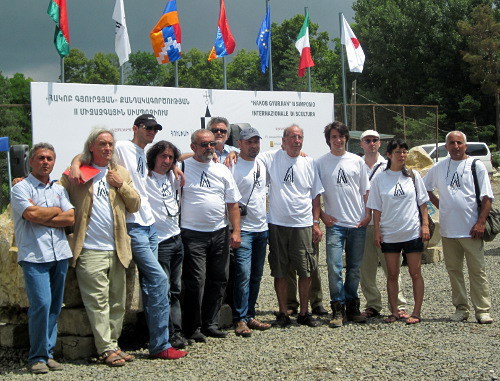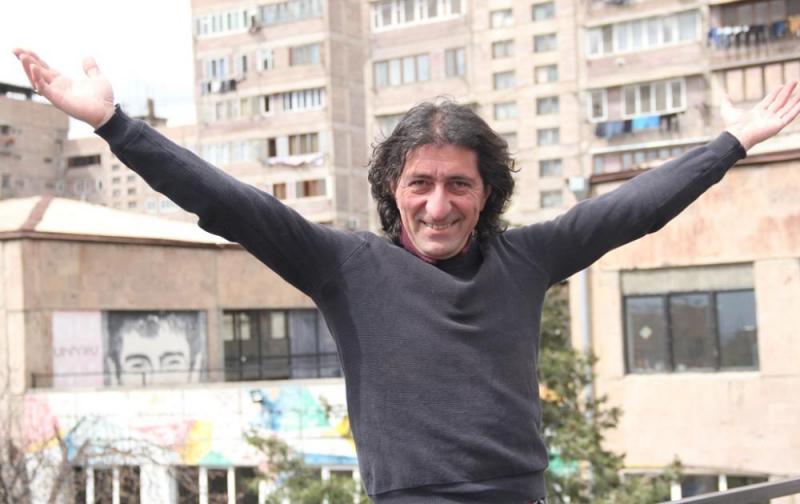
The interview of teacher, sculptor Vigen Avetis is taken by 11th grader Gayane Poghosyan in March. It was interpreted and translated by 11th grader Iren Gevorgyan.
The war ended, but people continue to live. In this project we want to talk to people who inspire us. Today we are talking to Vigen Avetis sculpture school head, the organizer of the Armenian Renaissance Movement in Florence, a member of the Union of “40 Florentines”, and public figure Vigen Avetis. What activities does the Vigen Avetis sculpture school of Mkhitar Sebastatsi EduComplex carry out?

Hello, I liked the ‘but’ in your sentence, but I would say the opposite. People were living, but the war was unleashed, not the other way.
The school should have a big role in the life of society. Every child is part of a ‘family’ consisting of 3, 4, 5 people. This means when a child starts sculpting and creating art, the art enters their family as well, and the family’s atmosphere becomes more peaceful and artsy, meaning the situation caused by the war is getting easier to defeat, so my work in Mkhitar Sebastatsi is also connected with children’s families.
This year we are going to start a marathon which will be called “Hayeren”, in all its meanings – the language, the lifestyle, and the way of thinking. The main purpose of the marathon will be focusing on the Armenian language using different methods such as sculpting and living as “Armenian”.
So, when will the marathon start?

It has already started, but when the weather gets warmer we will take practical steps.
Sounds exciting. Why did you return from Italy? Wasn’t it good there?

I never ‘return’. I always travel. Traveling is endless. When a person is born, they start traveling from the first day, and the travel lasts their whole life. For me there is not such thing as returning or leaving. I didn’t leave Armenia or Italy, it’s just I travel, I don’t know what’s next and where I am going to be. I live the same way I lived in Italy and probably would live like this in any other country.
As we know in 2011 and 2012 you organized International Sculpture Symposiums of Shushi. You applied to the Public Council of the Republic of Armenia to have support transferring many pieces of art from Artsakh to the Republic of Armenia. What is going on with that situation?

Yes, in 2011, I initiated the International Sculpture Marathon. I understood the secret and the importance of valuing and regaining our culture in 1991, and tried to draw the attention of people and the government by organizing a marathon.
Symposium was aimed at creating an arena of cooperation, cultural and professional dialogue and creative inspiration. It also has an objective to raise Artsakh’s international reputation through art.
The attention was mainly provided to arts and culture, because they are the evidence of our history. We should protect the historical pieces and create new art. And I succeeded, but the government of that time didn’t understand the main point of the marathons, and today our cultural values of Artsakh are captured by the enemy and are probably going to be destroyed. We should have thought about this before and taken action to prevent the unfortunate events. But our government still does not understand the responsibility of being Armenian. I even caught the attention of the Italian governors which were ready to help, yet our authorities have not done anything and there is not a single difference or change. We have no information about the condition of our art.
It is very upsetting. What is the “residence without fences” project? What obstacles did you encounter in implementing it?
The main obstacle was me, Ashot Bleyan and two more teachers getting arrested. They filed a lawsuit against us. The trial should have been in January, but the Constitutional Court decided that they would not adjudicate us. I and Ashot Bleyan have decided to sue them for their illegal actions, because arresting the director and some teachers in the school yard is a very wrong thing to do.
This is what the “without fences” is about, because we need to realize that fences are not our future, but the peace of mind, love and respect towards each other and our culture is. Whatever is happening now in the political field is directly connected with the fences. What was the attitude towards the beauty, towards the purity, the patriotism? This was a little episode of our lives, which proved that we had already lost the war before it even started.
Unfortunately. And the last question is about your memorable projects. Are there any you would like to refer to?
My project is living. I really want to live. But I make steps to live. You need to have thoughts and ideas to exist, and start finding ways to bring them to life.

You should work hard on yourself for all your goals to be achieved, because they will stay unaccomplished if you don’t give them wings. As you know, chickens have wings, but they can’t fly, that’s why we need to grow our wings and only then try to fly. Let’s not be chickens and be birds who can fly, instead of living our lives like chicken-doing nothing and dreaming about flying.
Thank you for taking your time for us.
Thank you too.
The interview was conducted by 11th grader Gayane Poghosyan and translated by 11th grader Iren Gevorgyan within the framework of “People who inspire us” project.
